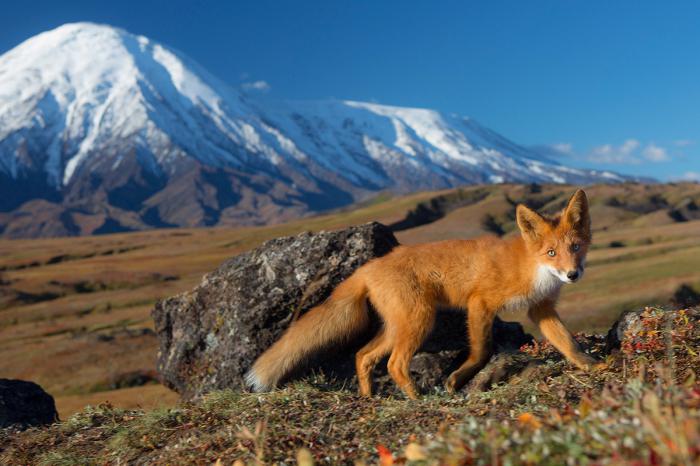The nature of Russia is amazing and diverse . Kamchatka is a unique mountainous region. It is distinguished by the originality of the landscape, the harsh climate, the wealth of flora and fauna.
Geography of the region
Kamchatka, whose nature constantly surprises researchers, is a peninsula in northeastern Eurasia. It is washed by the Sea of Okhotsk and the Bering Sea, as well as the Pacific Ocean. It has an elongated shape, extends from north to south for 1200 km, its maximum width does not exceed 440 km. The area of Kamchatka is approximately 270 thousand square meters. km
The peninsula is connected to the mainland by a narrow isthmus, the cross section of which is only about 90 km.
The west coast is flat and lowland, swampy in some places. The east coast is a steep rocky line, indented by bays and bays.
The peninsula is crossed by many rivers. Almost all of them originate in glaciers or at the foot of the mountains. The water in them is very clean, suitable for drinking without purification and boiling. The largest river is Kamchatka. There are also many lakes.
Zone of Modern Volcanism
What is Kamchatka interesting for? Nature generously endowed it with volcanoes. There are more than 2.5 thousand volcanic cones - about 300 extinct and more than 30 active volcanoes. They are the main attraction of the peninsula. Poets call them stone torches, they are depicted on the coat of arms and flag of the region.
One of the most interesting active volcanoes in Kamchatka is Ichinsky, the height of which is 3621 meters. It strikes the imagination with its size and shape. A very unusual and beautiful sight is the periodic emissions of blue obsidian.
In Kamchatka there is the highest volcano of Eurasia - Klyuchevskaya Sopka, whose peak reaches 4750 meters. In addition to his “growth”, he is distinguished by an absolutely regular classical form. Around it are 12 smaller volcanoes. The whole group is declared a natural park.
In the south of the peninsula is another group of volcanoes, called "Home". It includes Kozelsky (2190 meters), Avachinsky (2751 meters) and Koryaksky (3456 meters) volcanoes.
Avacha, Mutnovsky and Karymsky are some of the most active volcanoes. The last eruption of Avachi was recorded in 1991, and Karymsky since 1996 has been showing continuous activity.
From a scientific point of view, Kamchatka is a natural laboratory for the creation of volcanoes. The entire scientific world observes the unique processes of their birth, taking place literally before our eyes, as in prehistoric times.
The peninsula is a seismically active zone. Earthquakes shake it periodically, the strength of individual reaches 9-10 points.
Climate
In Kamchatka, a humid and cool climate prevails. It is colder and windier in the lowlands than in the highlands. A snowy, with frequent snowstorms, winter comes in November and actually lasts until the end of April. Only in May, a short, swift spring passes, and after it is the same short summer, often rainy, sometimes quite hot, but always colored by a riot of colors of flowering herbs. Autumn is most often cloudy and warm.
Flora and fauna
The wildlife of Kamchatka is almost untouched by man. In total, Kamchatka has about 1200 species of plants - trees, shrubs and grasses. Some of which are endemic, that is, they are not found anywhere else on the planet.
Alpine vegetation prevails on the coast; above 1400 meters above sea level - mountain tundra, even higher - wastelands with sparse vegetation. The peninsula is characterized by tall grass. Grass grows 3-4 meters! In spring and summer, they bloom violently, so Kamchatka open spaces, like in a kaleidoscope, flood waves of color - the dominance of greenery is replaced by lilac, which is gradually diluted with white, and then replaced by deep purple, which in turn replaces saturated orange, and then bright yellow and red. Each color lasts about a week. The pride of the peninsula is the orchid venus slipper, Ridera's swimsuit, meat-red meat, toposhkovaya rose and other plants.

The fauna of Kamchatka is also diverse: 500 species of fish, 300 species of birds, 90 species of mammals - sable, ermine, flying squirrel, hare, otter, lynx, reindeer, polar wolf, fox and others. Of the predators, the Kamchatka brown bear is considered the most dangerous. The most numerous representatives of the land fauna are insects, which make up 80% of all animal species of the peninsula taken together.
The economy of the region
Unique Land - Kamchatka. Her nature is harsh, colorful and magnificent. The harsh climate, low population and undeveloped most of the territory make this region one of the most environmentally friendly places on the planet. There is not a single railway, the main transport links are air (airplanes and helicopters), sea and automobile.
The administrative center and largest city is Petropavlovsk-Kamchatsky with a population of 200 thousand people. Other significant settlements - Yelizovo, Paratunka, Milkovo, Esso, Anavgay, Ust-Kamchatsk, Kozerevsk and others.
Fisheries, metallurgy, and agriculture are mainly developed in the region. Tourism has been developing very rapidly in recent decades. Kamchatka, whose nature is unusual, colorful and harsh, attracts thousands of extreme sportsmen who not only ski or dog sled, but also conquer mountain peaks, descend into the craters of volcanoes, and visit the Valley of Geysers. A feature of Kamchatka routes is their inaccessibility and unpredictability, so you should definitely use the services of an experienced guide.